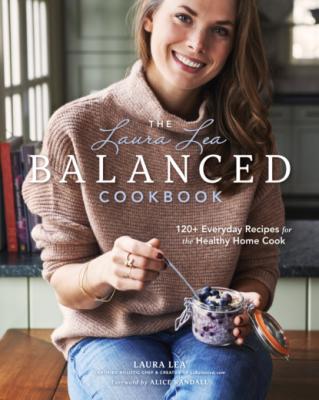The Laura Lea Balanced Cookbook. Laura Lea
Читать онлайн.| Название | The Laura Lea Balanced Cookbook |
|---|---|
| Автор произведения | Laura Lea |
| Жанр | Кулинария |
| Серия | Laura Lea Balanced |
| Издательство | Кулинария |
| Год выпуска | 0 |
| isbn | 9781951217112 |
panacea it has been blown up to be, unrefined
organic coconut oil is an extremely nutrient-
dense food. The monounsaturated fatty acids
in coconut are anti-inflammatory, and they’re
used immediately by our body for energy
instead of being stored first, as other fats are.
One specific fatty acid called lauric acid has
antiviral, antibacterial properties, which can
benefit our immune system in helping fight
pathogens. Plus, it’s a great alternative to olive
oil and butter in cooking, as it lends a lovely,
mild coconut flavor to food.
Other uses: Topically, coconut oil can be
a great body moisturizer for your skin—
test a small amount to ensure there’s no
negative reaction.
Where to find: Most grocery stores, Whole
Foods, The Fresh Market, Trader Joe’s,
Amazon, Vitacost, Thrive Market
Toasted sesame oil: Oh, how I love toasted
sesame oil! It has the most wonderful nutty
flavor. You only need a small amount to create
that signature taste found in many Asian
cuisines. There really is no good substitution
for it, but know that one bottle lasts for a very
long time. On the health front, sesame seeds
and sesame oil are high in minerals such
as zinc, which boosts collagen production
for elastic, supple skin. Sesame is also a
great source of specific anti-inflammatory
compounds that promote heart health.
Other uses: Toasted sesame oil is amazing as
a quick salad dressing—just drizzle it on
greens with a splash of red wine vinegar,
sprinkle on some sea salt and voila! Totally
delicious. You can also use it as a finishing oil
for any roasted meat, seafood, or vegetables.
Where to find: Most grocery stores (in the
ethnic foods section), almost all health-food
stores, most Asian stores, Whole Foods, Trader
Joe’s, Amazon, Vitacost, Thrive Market
Nutritional yeast: Okay, I know, not the best
name for a food. But it makes up for it in
versatility! Nutritional yeast is simply a dried
mushroom/fungus, and it happens to have a
delicious cheeselike flavor. Nutritional yeast
adds a layer of umami, the elusive fifth taste
found in meat and certain foods such as
sun-dried tomatoes. Umami adds complexity
to recipes and makes people ask “What’s in
here?” Nutritional yeast is also a fantastic
source of B vitamins, which can be difficult
to obtain in a vegan or vegetarian diet. If
you are on the strictly plant-based train,
nutritional yeast is likely a great addition to
your cooking repertoire.
Other uses: Sprinkle it on popcorn, then drizzle
with some olive oil and sea salt. Combine 1
cup nuts of choice with 2 to 3 tablespoons of
nutritional yeast and ½ teaspoon sea salt, then
pulse until it forms the consistency of a grainy
flour. This makes a yummy alternative to
parmesan cheese and can keep sealed tightly
in your pantry for up to a month.
Where to find: Most health-food stores, Whole
Foods, Amazon, Vitacost, Thrive Market
Tahini paste: You will see tahini paste scattered
throughout this cookbook, and for good
reason. Nutty, savory tahini paste is incredibly
versatile, and it offers umami and depth to
dairy-free dishes in particular. Tahini is simply
ground sesame seeds, the seed version of an
almond or peanut butter. Considered exotic
only a few years ago, tahini can now be found
in most grocery stores. I love tahini for its
health benefits as well. It is a fantastic source
of essential vitamins and minerals like copper,
calcium, iron, vitamin E, and B vitamins.
Tahini has been said to help with everything
from lowering blood pressure to regulating
hormones to improving skin health and
nutrient absorption. Once you start playing
around with this unique ingredient, you will
always want it in your refrigerator.
Other uses: Besides the copious uses in
my cookbook, tahini is fantastic as a simple
spread. I love it on rye toast with a smear
of raspberry jam. You can use it as a
substitute for nut butters, but note that it
will be less sweet.
Where to find: It is often near the other nut
butters in grocery stores, but sometimes it
is in the exotic ingredients section. You can
also order it from Vitacost, Amazon, or Thrive
Market. My favorite brand is Joyva.
Unsulphured apricots: When you think of dried
apricots, your mind likely pictures something
neon-orange. These apricots have been treated
with preservatives, causing an unnatural color
and mediocre flavor. Unsulphured apricots are
in a league of their own. They have a wonderful
rich flavor with caramel notes, as well as a
softer texture. Dried apricots are fabulous for
digestion with their high fiber content, and
they also contain the antioxidant carotene.
Don’t fear their darker color—that’s the good
stuff. I use them in my Apricot & Olive Oil
Granola
